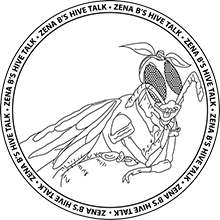Hive Talk - November 2020
Hive Talk Nov 2020

Zena Bees - Hive Talk November 2020 Since my last report in October, the activities in the hives have been really quiet. However, before this dump of snow, I went out to the hives to fill their water supply and bent over to see what I could see in their entrances. Much to my relief there were guard bees all lined up across the entrance (about 2”) staring back at me. They weren’t coming out but were ready to ask what I was up to! It was so cute! All these little faces looking out at me, ready for action! When I checked on the ground, in front of the hive, I found many drone bees laying dead. Unfortunately that is the way the hive reduces the unnecessary population. Only the essential Worker bees are needed for the survival of the colony. During the winter months the bees’ metabolism slows down and they only use their shoulder muscles shiver to keep their ‘Queen’ warm. The worker bees maintain the temperature around the Queen to 92 Degrees Fahrenheit! They also rotate their position in the cluster so that the outside bees make their way to the centre, and the inside bees make their way to the outside. The cluster will also move around the hive to consume the food stores, but only when the weather warms up enough to encourage the cluster movement. When the weather heats up to +5 the bees will come out to do a quick ‘cleansing’ flight. That is a polite way to say that they will come out to poop. The bees are very hygienic and will wait for months to defecate only when the outside temperatures encourage them to leave the hive for a quick flight. During the months from November to February the queen stops laying eggs. Her subjects feed her and clean her and protect her, and keep her warm throughout the winter. ‘Winter’ bees live longer than ‘Summer’ sister bees. They do not need to forage which shortens their life due to the extreme efforts they need to forage for food outside the hive. Summer bees live for only 5 - 7 weeks, and the ‘Winter’ bees live for 4 - 6 months. In the last part of January, beginning of February the Queen will start laying eggs to prepare her hive for additional workers and for the busy months ahead. At that point she will also lay unfertilized eggs, which developed into drones. When they are mature they will go out for mating flights with other queens to start the cycle over again. I have two hives so I hope there is enough genetics to produce strong and healthy colonies. If not, I’ll have to re-queen in the spring with newly mated queens, from another apiary. Last month I mentioned that the bees were super sealing up their hives with propolis. This prevents any drafts from entering the hive while they wait out their winter captivity. I think the bees knew what was coming….Fun fact: I’ve ordered a pair of snowshoes so that I can get out to the hives to make sure their entrances are open and that there is adequate ventilation. There is always a risk that the condensation will build up at the entrances and block the openings with ice! On extremely cold days you can see a little steam coming out of the hives. Wish me luck! I haven’t checked the ‘Snarples’ score, but I will report it in the spring when I can open up the hives.
